Heat resistant glassware has revolutionized cooking, baking, and food storage by offering unparalleled durability and safety when exposed to high temperatures.
Unlike regular glass that can shatter when subjected to sudden temperature changes, heat proof glass cookware is specifically engineered to withstand extreme thermal conditions without compromising structural integrity.
Whether you’re a professional chef working with commercial ovens, a home baker creating delicate soufflés, or a laboratory technician handling heated materials, understanding the science and applications of temperature resistant glassware is essential for both safety and optimal performance.
This comprehensive guide explores everything from the molecular composition that makes glass heat resistant to practical buying advice for selecting the perfect thermal shock resistant glass for your specific needs.
The importance of high temperature resistant glassware extends beyond mere convenience.
It represents a crucial safety innovation that prevents dangerous shattering incidents while maintaining the clarity and non-reactive properties that make glass superior to many other materials.
From borosilicate laboratory beakers that withstand flames to elegant oven-safe baking dishes that transition seamlessly from freezer to oven, heat resistant glass has become an indispensable part of modern kitchens and professional environments.
Understanding Heat Resistant Glass Science
The secret behind heat resistant glassware lies in its unique molecular composition and manufacturing process.
Traditional soda-lime glass, commonly used in windows and basic containers, has a high coefficient of thermal expansion, meaning it expands and contracts significantly with temperature changes.
This expansion creates internal stress that leads to cracking and shattering when exposed to rapid temperature variations.
Heat resistant glass, particularly borosilicate glass, contains boron oxide (B₂O₃) in addition to silica (SiO₂), dramatically reducing its thermal expansion coefficient.
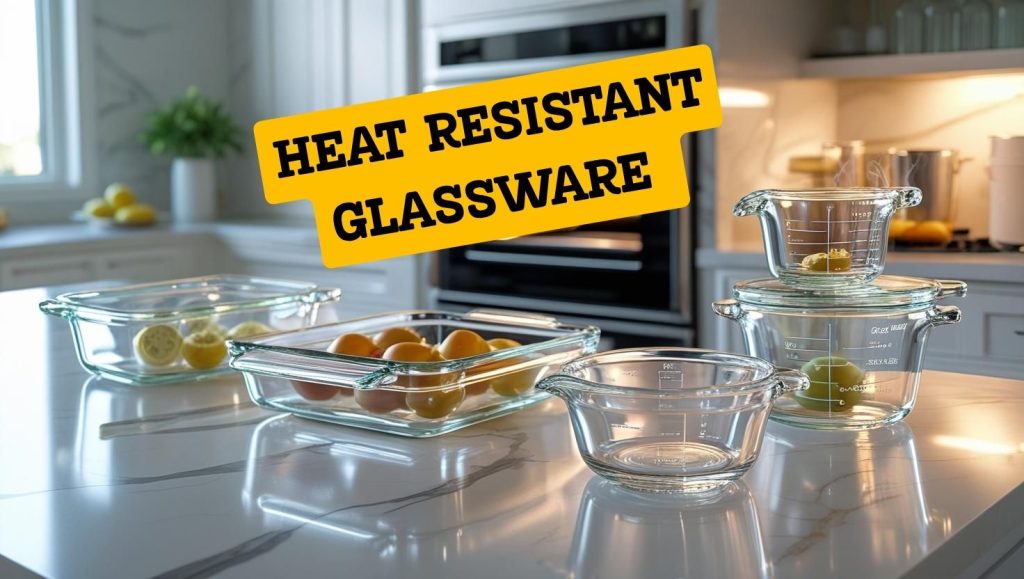
This means the glass expands and contracts much less when heated or cooled, creating far less internal stress.
The glass transition temperature: the point where glass begins to soften, is also higher in heat resistant varieties, allowing them to maintain their shape and strength at elevated temperatures.
Thermal shock resistance is measured by the maximum temperature difference a glass can withstand without breaking.
Regular glass typically fails with temperature differences of 40-50°C (72-90°F), while quality heat resistant glassware can handle temperature differentials of 120-160°C (216-288°F) or more.
The best borosilicate glass can withstand direct flame contact and temperature variations exceeding 200°C (360°F).
Temperature ratings for heat resistant glass vary by type and quality, with most kitchen-grade pieces safely handling continuous temperatures between 200-300°C (392-572°F).
Laboratory and industrial grades often exceed 500°C (932°F), making them suitable for specialized high-temperature applications.
Understanding these ratings is crucial for selecting appropriate glassware for specific tasks and ensuring long-term durability.
Types of Heat Resistant Glass
Borosilicate Glass
Borosilicate glass represents the gold standard in heat proof glassware, containing 10-20% boron oxide that dramatically reduces thermal expansion.
Originally developed by German glassmaker Otto Schott in the 1890s, this remarkable material can withstand temperature ranges from -40°C to over 500°C (-40°F to 932°F) depending on thickness and quality.
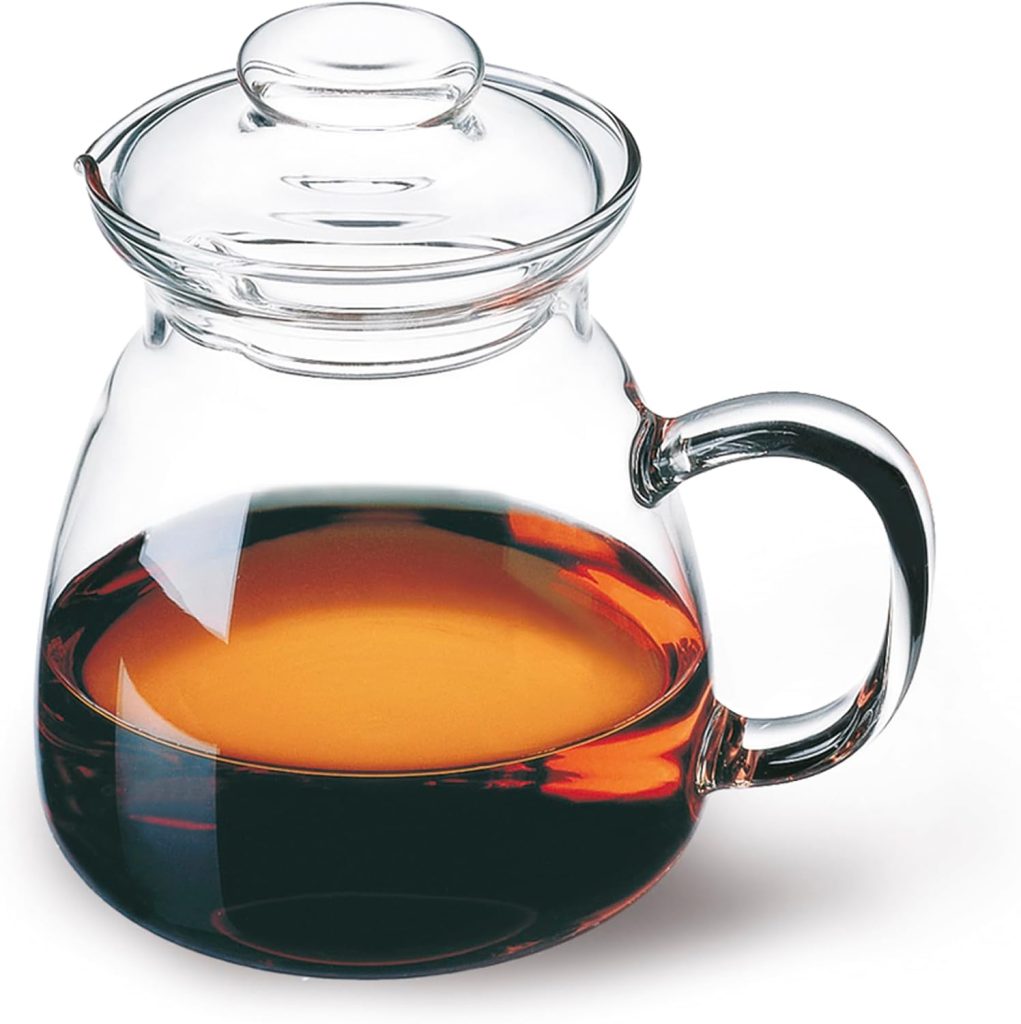
The low expansion coefficient of 3.3 × 10⁻⁶/K makes it ideal for applications requiring precise temperature control and thermal stability.
In kitchen applications, borosilicate glass excels in baking dishes, measuring cups, and storage containers that need to transition between extreme temperatures.
Its excellent optical clarity and chemical resistance make it perfect for both functional and presentation purposes.
Laboratory-grade borosilicate glass features even higher purity and can withstand direct flame contact, making it indispensable for scientific applications.
Tempered Glass
Tempered glass undergoes a controlled thermal treatment process where it’s heated to approximately 650°C (1200°F) then rapidly cooled with jets of cold air.
This process creates compressive stress on the surface while maintaining tensile stress in the interior, resulting in glass that’s 4-5 times stronger than regular glass.
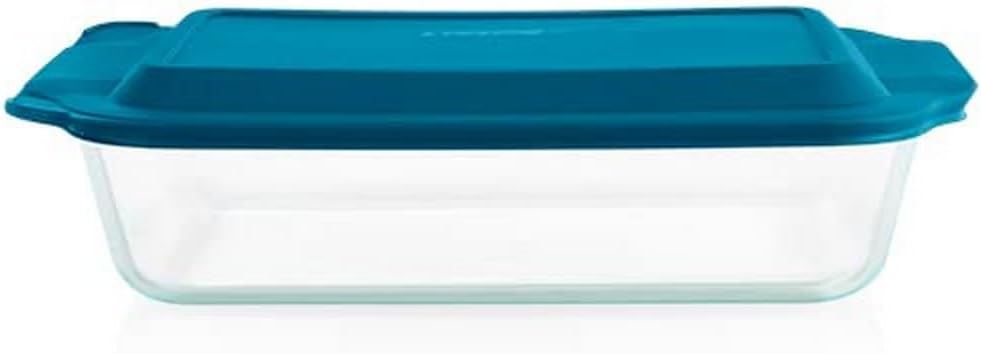
While not as thermally resistant as borosilicate, quality tempered glass can handle temperature differences of 120-150°C (216-270°F).
The unique breaking pattern of tempered glass, shattering into small, relatively harmless cubes rather than sharp shards makes it particularly valuable for safety-critical applications.
Tempered glass cookware provides excellent heat distribution and can safely transition from refrigerator to oven, though it requires more careful handling of temperature extremes compared to borosilicate alternatives.
Aluminosilicate Glass
Aluminosilicate glass incorporates aluminum oxide (Al₂O₃) into its composition, creating exceptional strength and temperature resistance.
This specialized glass can withstand continuous temperatures up to 400°C (752°F) and brief exposures to even higher temperatures.
The addition of aluminum creates a glass with superior mechanical properties and excellent resistance to thermal shock.
Primarily used in high-end cookware and specialized industrial applications, aluminosilicate glass offers the benefit of being thinner and lighter than comparable borosilicate pieces while maintaining superior strength.
Its excellent chemical durability makes it resistant to alkaline solutions and most acids, ensuring long-term performance in demanding environments.
Glass-Ceramic (Pyroceram)
Glass-ceramic materials represent the ultimate in heat resistance, capable of withstanding temperatures exceeding 700°C (1292°F).
Created through controlled crystallization of glass, these materials combine the thermal shock resistance of ceramics with the manufacturing flexibility of glass.
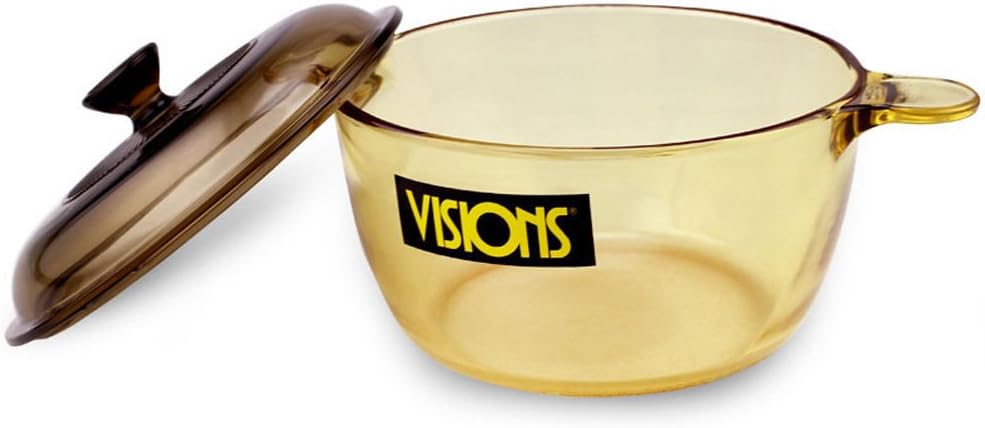
The microscopic crystal structure provides exceptional strength and virtually zero thermal expansion.
While primarily used in specialized applications like cooktop surfaces and industrial furnace windows, glass-ceramic technology has found applications in premium cookware.
These materials can safely handle direct stovetop heating and extreme temperature variations that would destroy conventional glass, making them ideal for professional cooking environments and specialized culinary techniques.
Applications and Use Cases
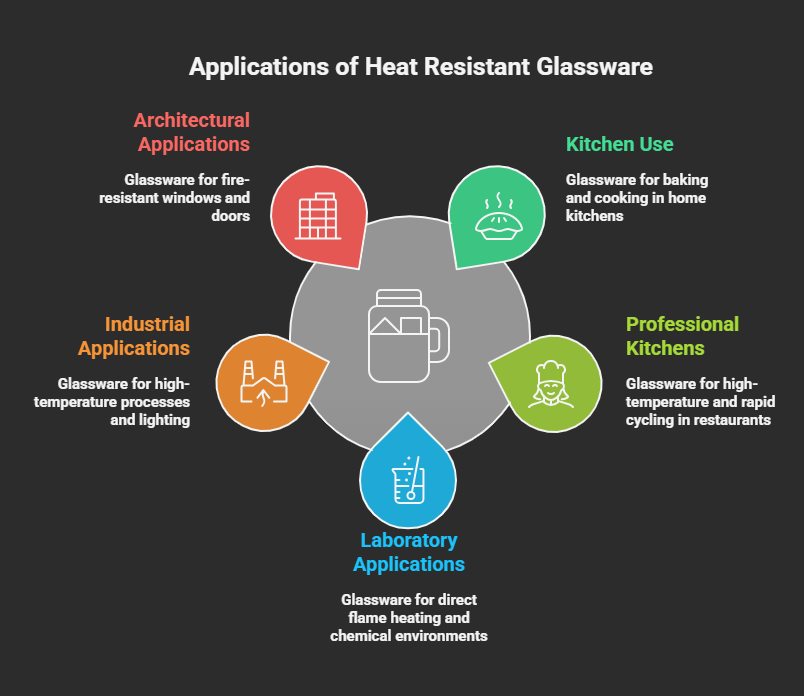
Heat resistant glassware serves diverse applications across multiple industries, with kitchen and culinary uses representing the most common consumer applications.
In home kitchens, oven safe glassware includes baking dishes, casserole pans, pie plates, and roasting pans that can safely handle temperatures from freezer storage through high-temperature baking.
The non-reactive nature of glass prevents flavor transfer and chemical leaching, making it ideal for acidic foods and long-term storage.
Professional kitchens demand high temperature glassware that can withstand commercial oven temperatures and rapid temperature cycling.
Restaurant-grade glass cookware must handle the thermal stress of busy service environments while maintaining food safety standards.
Specialized applications include flambé dishes designed for alcohol ignition and serving pieces that maintain temperature for extended periods.
Laboratory applications require the highest grades of heat resistant glassware, with beakers, flasks, and reaction vessels designed to handle direct flame heating and aggressive chemical environments.
Scientific glassware must maintain precise dimensional stability under temperature stress while providing excellent optical clarity for observation.
Specialized laboratory glass includes distillation apparatus, condensers, and high-temperature reaction chambers.
Industrial applications encompass sight glasses for high-temperature processes, lighting fixtures for extreme environments, and protective barriers for furnaces and kilns.
Architectural applications include fire-resistant windows and doors designed to maintain structural integrity during fire emergencies.
These specialized glasses often incorporate additional safety features like wire reinforcement or specialized coatings.
Popular Heat Resistant Glass Brands
The heat resistant glassware market features several established manufacturers known for quality and innovation.
Understanding brand characteristics helps consumers make informed decisions based on specific needs and applications.
Anchor Hocking
This American glassware brand has established itself as a leading American manufacturer of heatproof glassware, producing everything from basic measuring cups to sophisticated baking systems.
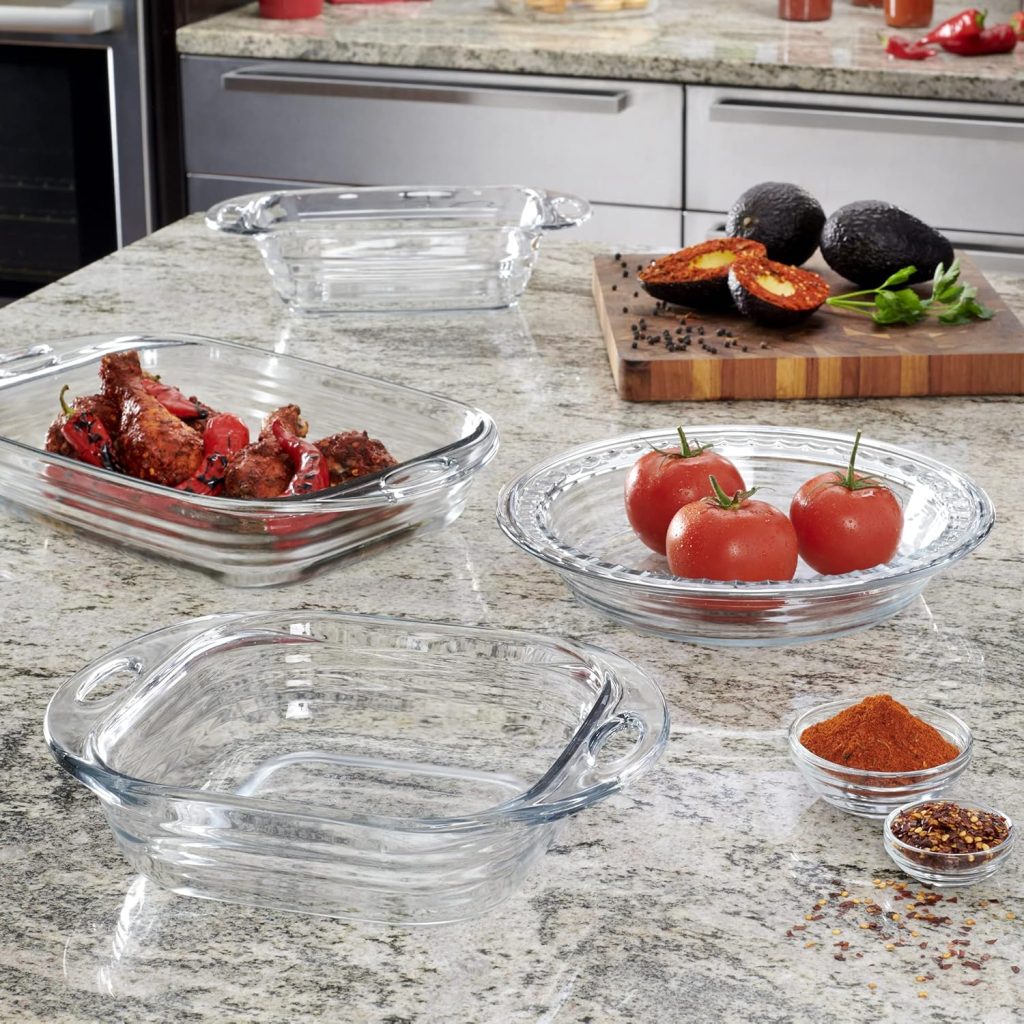
Their borosilicate and tempered glass products offer reliable performance at accessible price points, making quality temperature resistant glassware available to homes and professional kitchens alike.
Anchor Hocking’s extensive product line includes specialized items like loaf pans, cake dishes, and storage containers designed for temperature extremes.
Libbey Glass
The Libbey brand represents over 200 years of American glassmaking expertise, with their heat resistant products featuring superior clarity and durability.
Known for precision manufacturing and consistent quality control, Libbey produces both consumer and commercial-grade heat resistant glassware.

Their tempered glass products are particularly noted for even heat distribution and resistance to thermal shock, making them popular choices for both home and professional applications.
Duralex
The Duralex glass brand brings French engineering precision to pyrex alternative resistant glassware, utilizing advanced tempering processes that create exceptionally strong and durable products.

Their unique manufacturing technique produces glass with superior impact resistance alongside excellent thermal properties.
Duralex products are recognized for their ability to withstand extreme temperature variations while maintaining structural integrity over extended use periods.
Luminarc
The Luminarc brand is part of the Arc International group, offers an extensive range of heat resistant drinking glasses, oven and serving pieces that combine functional performance with elegant design.
Their products excel in applications requiring both thermal resistance and aesthetic appeal, making them popular for both everyday use and special occasions.
Luminarc’s innovative designs often incorporate ergonomic features that enhance safety and usability.
Specialized Applications
Specialized applications often benefit from dedicated products like mason jars designed for high-temperature canning processes.
These containers must withstand the thermal stress of pressure canning while maintaining hermetic seals for food safety.
Fire King Glass, produced by Anchor Hocking from the 1940s to 1970s, was specifically designed as heat resistant for both cooking and serving applications, making it highly sought after by collectors and users who appreciate its proven thermal durability and vintage aesthetic.
Historical depression glass pieces, while not meeting modern heat resistance standards, demonstrate the evolution of glass technology and the increasing sophistication of thermal engineering in glassware design.
Modern reproductions often incorporate contemporary heat resistant technologies while maintaining classic aesthetic appeal.
How to Choose Heat Resistant Glassware

Selecting appropriate thermal shock resistant glassware requires careful consideration of intended applications, temperature requirements, and quality indicators.
The first step involves assessing your specific temperature needs, basic oven use requires different specifications than stovetop cooking or laboratory applications.
Temperature ratings should match or exceed your intended use, with safety margins for unexpected temperature variations.
Quality heat proof glassware clearly displays maximum temperature ratings and thermal shock resistance specifications.
Look for certifications from recognized safety organizations like FDA approval for food contact surfaces and compliance with international safety standards.
Glass thickness affects both thermal properties and durability, with thicker pieces generally offering better heat retention but potentially greater thermal stress.
The shape and design should promote even heat distribution while minimizing stress concentration points that could lead to failure.
Handles and grips should be designed to remain cool during use and provide secure handling even with oven mitts.
Brand reputation and warranty coverage indicate manufacturer confidence in product quality and provide recourse for premature failure.
Established manufacturers typically offer comprehensive product information including specific temperature limits, care instructions, and replacement part availability.
Price comparison should consider long-term value rather than initial cost, as quality heat resistant glassware provides years of reliable service.
Purchasing sources affect both product authenticity and after-sale support, with authorized dealers offering genuine products and full warranty coverage.
Online retailers provide convenience and often competitive pricing, but verification of seller legitimacy is essential for warranty protection.
Specialty kitchen stores offer expert advice and hands-on product evaluation, while wholesale suppliers serve commercial applications with volume pricing and professional-grade products.
Proper Care and Maintenance
Maintaining temperature resistant glassware properly extends its lifespan and ensures continued safe performance.
While these products are designed for temperature extremes, proper care prevents premature failure and maintains optimal appearance.
Cleaning should begin only after glassware has returned to room temperature, as thermal shock can occur even with heat resistant materials if temperature changes are too rapid.
Use warm, soapy water and soft cloths or sponges to avoid scratching surfaces that could become stress concentration points.
Avoid abrasive cleaners or steel wool that can compromise the glass surface integrity.
Dishwasher use is generally safe for quality heat resistant glassware, but verify manufacturer recommendations as some specialized coatings or decorative elements may require hand washing.
Use appropriate dishwasher cycles and avoid high-temperature drying settings that could cause thermal stress when combined with detergent residues.
Develop a storage practice culture that minimizes mechanical stress and protect surfaces from impact damage.
Stack pieces with protective padding or store separately to prevent contact damage.
Avoid storing heavy items inside glass containers and ensure adequate support for larger pieces to prevent stress concentration.
Temperature transition management remains important even with heat resistant glass.
Allow gradual temperature changes when possible, and avoid placing very hot glassware on cold surfaces or exposing cold glass to sudden heat.
While quality oven safe resistant glass can handle these transitions, gradual changes extend product life and maintain optimal performance.
Perform regular inspection for signs of wear, scratches, or stress marks helps identify pieces that may need replacement before failure occurs.
Small chips or cracks can become failure initiation points under thermal stress, so damaged pieces should be retired from high-temperature service even if they appear functional.
Safety Guidelines and Best Practices
Heat resistant glassware safety begins with understanding and respecting temperature limits specified by manufacturers.
Even the best thermal shock resistant glass has upper limits that should never be exceeded.
Always verify temperature ratings before use and maintain safety margins for unexpected temperature spikes.
Proper handling techniques include using appropriate protective equipment like oven mitts or heat-resistant gloves when working with hot glassware.
Even handles designed to stay cool can become hot during extended high-temperature use.
Establish secure, heat-resistant work surfaces and clear pathways for moving hot glassware to prevent accidents.
Your preheating procedures should follow manufacturer guidelines, with gradual temperature increases preventing thermal shock even in heat resistant materials.
Avoid placing cold glassware directly into hot ovens, and allow appropriate preheating time for thick-walled pieces.
When using stovetop applications, start with low heat settings and increase gradually.
Have an emergency procedure established for dealing with broken glass, particularly when hot.
You should never attempt to clean up hot glass fragments with bare hands, we recommend you allow cooling before cleanup begins.
Keep appropriate cleanup materials readily available, including puncture-resistant disposal containers and protective equipment.
First aid preparations should address both thermal burns and cuts from glass fragments.
Maintain appropriate burn treatment supplies and know proper first aid procedures for both types of injuries.
Consider the proximity of emergency medical facilities when working with high-temperature applications, particularly in professional environments.
You should also consider the environment which include proper ventilation when heating glass to high temperatures, as thermal expansion can affect surrounding materials.
Lastly, ensure adequate clearance around hot glassware and consider thermal effects on nearby surfaces and materials.
Heat Resistant Glass vs Regular Glass
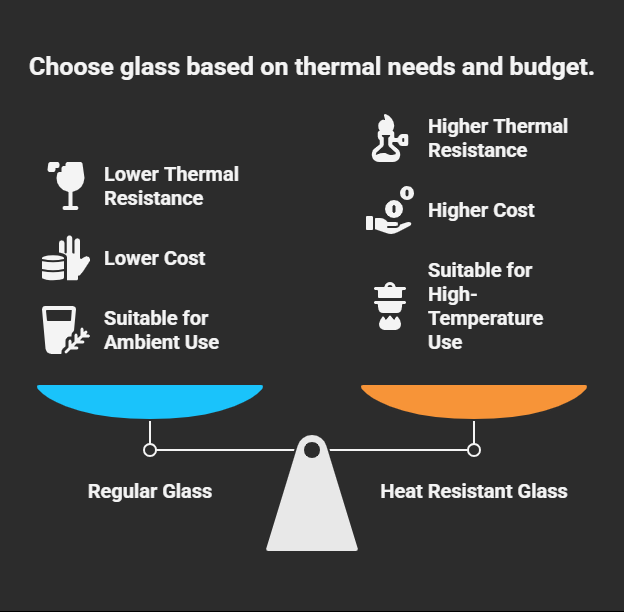
Understanding the fundamental differences between heat resistant and regular glass will help you make appropriate choices for specific applications.
Performance differences become apparent under temperature stress, where regular glass typically fails with temperature differences of 40-50°C while quality heat resistant glass handles differences exceeding 150°C.
This dramatic improvement comes from reduced thermal expansion and higher glass transition temperatures in specialty formulations.
The cost considerations reflect the specialized manufacturing processes and materials required for heat resistant properties.
While initial investment may be higher, the durability and safety benefits often justify the expense, particularly for frequent high-temperature use.
Regular glass remains appropriate for ambient temperature applications where thermal resistance isn’t required.
The structural differences extend beyond temperature resistance to include mechanical strength and chemical durability.
Heat resistant glass often exhibits superior impact resistance and chemical compatibility, making it suitable for aggressive cleaning agents and extended service life.
Their optical properties may differ slightly, with some heat resistant glasses showing minor color variations or optical distortions compared to standard glass.
Their application suitability should guide your selection decisions, with regular glass perfectly adequate for cold storage, room temperature serving, and decorative purposes.
Heat resistant glass becomes essential for oven use, stovetop cooking, and any application involving significant temperature variations.
Comparison Tables and Charts
| Glass Type | Max Temperature | Thermal Shock Resistance | Typical Applications |
| Regular Soda-Lime | 60°C (140°F) | 40-50°C difference | Cold storage, decoration |
| Tempered Glass | 250°C (482°F) | 120°C difference | Basic oven use, safety |
| Borosilicate | 500°C+ (932°F+) | 160°C+ difference | Laboratory, premium cooking |
| Aluminosilicate | 400°C (752°F) | 140°C difference | Professional cookware |
| Glass-Ceramic | 700°C+ (1292°F+) | 200°C+ difference | Extreme temperature use |
Brand Temperature Rating Comparison
| Brand | Glass Type | Maximum Temperature | Thermal Shock Rating |
| Anchor Hocking | Tempered/Borosilicate | 250-400°C | 120-160°C |
| Libbey | Tempered | 230°C | 110°C |
| Duralex | Advanced Tempered | 280°C | 130°C |
| Luminarc | Tempered | 250°C | 120°C |
Price Range Analysis
| Category | Price Range (USD) | Durability Rating | Best Value Applications |
| Basic Tempered | Low | Good (3-5 years) | Occasional oven use |
| Premium Tempered | Low – Mid | Very Good (5-8 years) | Regular cooking |
| Borosilicate | Mid – High | Excellent (10+ years) | Professional/frequent use |
| Specialty Glass | High | Superior (15+ years) | Commercial/laboratory |
Frequently Asked Questions
Yes, heat resistant glass is specifically designed for oven use, but always verify the manufacturer’s maximum temperature rating.
Most kitchen-grade heat resistant glass safely handles standard oven temperatures up to 250°C (482°F), while premium borosilicate pieces can withstand much higher temperatures.
Always allow gradual temperature changes and avoid placing cold glassware directly into hot ovens.
Temperature limits vary significantly by glass type and quality.
Basic tempered glass typically handles up to 250°C (482°F), while high-quality borosilicate glass can exceed 500°C (932°F).
Laboratory and industrial grades often withstand temperatures above 700°C (1292°F). Always check manufacturer specifications for specific temperature limits and safety margins.
No, regular soda-lime glass used in windows and basic containers has poor heat resistance and can shatter with temperature differences as small as 40°C (72°F).
Only specially formulated glasses like borosilicate, tempered, and aluminosilicate varieties offer true heat resistance.
Look for specific heat resistance ratings and manufacturer certifications when purchasing.
Heat resistant glass typically displays temperature ratings, manufacturer specifications, and safety certifications on packaging or product markings.
Look for terms like “borosilicate,” “tempered,” “oven safe,” or specific temperature limits.
If uncertain, contact the manufacturer or err on the side of caution by not exposing unmarked glass to high temperatures.
Heat resistant glass is a broader category that includes various formulations designed for temperature extremes, while tempered glass is a specific type that undergoes thermal treatment for strength.
All tempered glass has some heat resistance, but not all heat resistant glass is tempered.
Borosilicate glass, for example, achieves heat resistance through chemical composition rather than thermal treatment.
Yes, even heat resistant glass has limits for thermal shock.
While it can handle much larger temperature differences than regular glass, exceeding specified limits or extremely rapid temperature changes can still cause failure.
Quality heat resistant glass is designed with generous safety margins, but proper use practices should always be followed.
Conclusion
Heat resistant glassware represents a crucial advancement in kitchen safety and functionality, offering the perfect combination of thermal durability, chemical inertness, and optical clarity.
From basic tempered glass suitable for occasional oven use to advanced borosilicate formulations capable of withstanding extreme temperatures, there’s a heat resistant glass solution for virtually every application.
The key to successful heat resistant glassware selection lies in matching product specifications to intended use while considering factors like frequency of use, temperature requirements, and budget constraints.
Quality brands like Anchor Hocking, Libbey, Duralex, and Luminarc offer reliable products with clear temperature ratings and comprehensive warranties.
Proper care and maintenance ensure long-term performance and safety, while understanding the limitations and appropriate applications prevents accidents and premature failure.
Whether you’re a home cook seeking reliable baking dishes or a professional requiring commercial-grade thermal performance, thermal shock resistant glassware provides the durability and safety necessary for high-temperature applications.